List of mammals of Japan
This is a list of the mammal species recorded in Japan. There are 153 mammal species in Japan, of which three are critically endangered, twenty-two are endangered, thirteen are vulnerable, and two are near threatened. One of the species listed for Japan is considered to be extinct (See The Wild Mammals of Japan (2009, Ohdachi, S. D. et al. eds. Shoukadoh, Kyoto. ISBN 4-87974-626-6) for recent information.).[1]
The following tags are used to highlight each species' conservation status as assessed by the International Union for Conservation of Nature:
| EX | Extinct | No reasonable doubt that the last individual has died. |
| EW | Extinct in the wild | Known only to survive in captivity or as a naturalized populations well outside its previous range. |
| CR | Critically endangered | The species is in imminent risk of extinction in the wild. |
| EN | Endangered | The species is facing an extremely high risk of extinction in the wild. |
| VU | Vulnerable | The species is facing a high risk of extinction in the wild. |
| NT | Near threatened | The species does not meet any of the criteria that would categorise it as risking extinction but it is likely to do so in the future. |
| LC | Least concern | There are no current identifiable risks to the species. |
| DD | Data deficient | There is inadequate information to make an assessment of the risks to this species. |
Some species were assessed using an earlier set of criteria. Species assessed using this system have the following instead of near threatened and least concern categories:
| LR/cd | Lower risk/conservation dependent | Species which were the focus of conservation programmes and may have moved into a higher risk category if that programme was discontinued. |
| LR/nt | Lower risk/near threatened | Species which are close to being classified as vulnerable but are not the subject of conservation programmes. |
| LR/lc | Lower risk/least concern | Species for which there are no identifiable risks. |
Order: Sirenia (manatees and dugongs)

Sirenia is an order of fully aquatic, herbivorous mammals that inhabit rivers, estuaries, coastal marine waters, swamps, and marine wetlands. All four species are endangered.
- Family: Dugongidae
Order: Primates
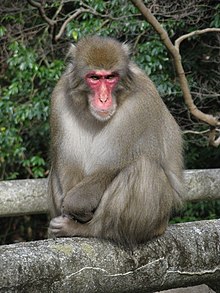
The order Primates contains humans and their closest relatives: lemurs, lorisoids, monkeys, and apes.
- Suborder: Haplorhini
- Infraorder: Simiiformes
- Parvorder: Catarrhini
- Superfamily: Cercopithecoidea
- Family: Cercopithecidae (Old World monkeys)
- Genus: Macaca
- Formosan rock macaque, M. cyclopsis LC introduced
- Japanese macaque, M. fuscata LC
- Genus: Macaca
- Family: Cercopithecidae (Old World monkeys)
- Superfamily: Cercopithecoidea
- Parvorder: Catarrhini
- Infraorder: Simiiformes
Order: Rodentia (rodents)
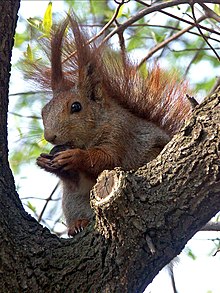
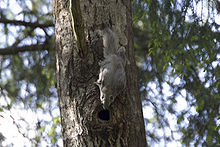


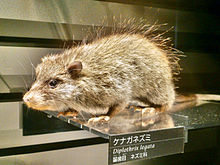
Rodents make up the largest order of mammals, with over 40% of mammalian species. They have two incisors in the upper and lower jaw which grow continually and must be kept short by gnawing. Most rodents are small though the capybara can weigh up to 45 kg (99 lb).
- Suborder: Sciurognathi
- Family: Sciuridae (squirrels)
- Subfamily: Sciurinae
- Tribe: Sciurini
- Genus: Sciurus
- Japanese squirrel, Sciurus lis LR/lc
- Red squirrel, Sciurus vulgaris NT
- Genus: Sciurus
- Tribe: Pteromyini
- Genus: Petaurista
- Japanese giant flying squirrel, Petaurista leucogenys LR/lc
- Genus: Pteromys
- Japanese dwarf flying squirrel, Pteromys momonga LR/lc
- Siberian flying squirrel, Pteromys volans LR/nt
- Genus: Petaurista
- Tribe: Sciurini
- Subfamily: Xerinae
- Tribe: Marmotini
- Genus: Tamias
- Siberian chipmunk, Tamias sibiricus LR/lc
- Genus: Tamias
- Tribe: Marmotini
- Subfamily: Sciurinae
- Family: Gliridae (dormice)
- Subfamily: Glirinae
- Genus: Glirulus
- Japanese dormouse, Glirulus japonicus EN
- Genus: Glirulus
- Subfamily: Glirinae
- Family: Cricetidae
- Subfamily: Arvicolinae
- Genus: Clethrionomys
- Hokkaido red-backed vole, Clethrionomys rex LR/nt
- Grey red-backed vole, Clethrionomys rufocanus LR/lc
- Northern red-backed vole, Clethrionomys rutilus LR/lc
- Shikotan vole, Clethrionomys sikotanensis LR/nt
- Genus: Microtus
- Japanese grass vole, Microtus montebelli LR/lc
- Genus: Myodes
- Japanese red-backed vole, Myodes andersoni VU
- Smith's vole, Myodes smithii LR/lc
- Genus: Clethrionomys
- Subfamily: Arvicolinae
- Family: Muridae (mice, rats, gerbils, etc.)
- Subfamily: Murinae
- Genus: Apodemus
- Small Japanese field mouse, Apodemus argenteus LR/lc
- Korean field mouse, Apodemus peninsulae LR/lc
- Large Japanese field mouse, Apodemus speciosus LR/lc
- Genus: Diplothrix
- Ryukyu long-tailed giant rat, Diplothrix legata EN
- Genus: Micromys
- Harvest mouse, Micromys minutus LR/nt
- Genus: Mus
- Ryukyu mouse, Mus caroli LR/lc
- Genus: Rattus
- Tanezumi rat, Rattus tanezumi LR/lc
- Genus: Tokudaia
- Muennink's spiny rat, Tokudaia muenninki CR
- Ryukyu spiny rat, Tokudaia osimensis EN
- Genus: Apodemus
- Subfamily: Murinae
- Family: Sciuridae (squirrels)
Order: Lagomorpha (lagomorphs)
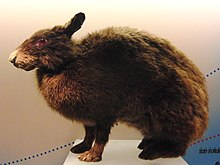

The lagomorphs comprise two families, Leporidae (hares and rabbits), and Ochotonidae (pikas). Though they can resemble rodents, and were classified as a superfamily in that order until the early 20th century, they have since been considered a separate order. They differ from rodents in a number of physical characteristics, such as having four incisors in the upper jaw rather than two.
- Genus: Lepus
- Japanese hare, Lepus brachyurus LR/lc
- Mountain hare, Lepus timidus LR/lc
- Genus: Lepus
- Family: Ochotonidae (pikas)
- Genus: Ochotona
- Northern pika, Ochotona hyperborea LR/lc
- Genus: Ochotona
- Family: Leporidae (rabbits, hares)
- Genus: Pentalagus
- Amami rabbit, Pentalagus furnessi EN
- Genus: Pentalagus
Order: Eulipotyphla (shrews, hedgehogs and moles )




Eulipotyphlans are insectivorous mammals. Shrews and solenodons resemble mice, hedgehogs carry spines, gymnures look more like large rats, while moles are stout-bodied burrowers.
- Family: Soricidae (shrews)
- Subfamily: Crocidurinae
- Genus: Crocidura
- Dsinezumi shrew, Crocidura dsinezumi LR/lc
- Horsfield's shrew, Crocidura horsfieldii LR/lc
- Ryukyu shrew, Crocidura orii EN
- Lesser white-toothed shrew, Crocidura suaveolens LR/lc
- Genus: Suncus
- Asian house shrew, Suncus murinus LR/lc
- Genus: Crocidura
- Subfamily: Soricinae
- Tribe: Nectogalini
- Genus: Chimarrogale
- Himalayan water shrew, Chimarrogale himalayica LR/lc
- Flat-headed water shrew, Chimarrogale platycephala LR/lc
- Genus: Chimarrogale
- Tribe: Soricini
- Genus: Sorex
- Slender shrew, Sorex gracillimus LR/lc
- Azumi shrew, Sorex hosonoi VU
- Eurasian least shrew, Sorex minutissimus LR/lc
- Sado shrew, Sorex sadonis EN
- Shinto shrew, Sorex shinto LR/lc
- Long-clawed shrew, Sorex unguiculatus LR/lc
- Genus: Sorex
- Tribe: Nectogalini
- Subfamily: Crocidurinae
- Family: Talpidae (moles)
- Subfamily: Talpinae
- Genus: Nesoscaptor
- Ryukyu mole, Nesoscaptor uchidai EN
- Tribe: Talpini
- Genus: Euroscaptor
- Japanese mountain mole, Euroscaptor mizura VU
- Genus: Mogera
- Echigo mole, Mogera etigo EN
- Kobe mole, Mogera kobeae LR/lc
- Small Japanese mole, Mogera minor LR/lc
- Tokuda's mole, Mogera tokudae EN
- Japanese mole, Mogera wogura LR/lc
- Genus: Euroscaptor
- Tribe: Urotrichini
- Genus: Urotrichus
- True's shrew mole, Urotrichus pilirostris LR/lc
- Japanese shrew mole, Urotrichus talpoides LR/lc
- Genus: Urotrichus
- Genus: Nesoscaptor
- Subfamily: Talpinae
Order: Chiroptera (bats)




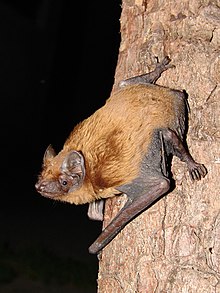

The bats' most distinguishing feature is that their forelimbs are developed as wings, making them the only mammals capable of flight. Bat species account for about 20% of all mammals.
- Family: Pteropodidae (flying foxes, Old World fruit bats)
- Subfamily: Pteropodinae
- Genus: Pteropus
- Ryukyu flying fox, Pteropus dasymallus EN
- Okinawa flying fox, Pteropus loochoensis DD
- Mariana fruit bat, Pteropus mariannus EN
- Bonin flying fox, Pteropus pselaphon EN
- Genus: Pteropus
- Subfamily: Pteropodinae
- Family: Vespertilionidae
- Subfamily: Myotinae
- Genus: Myotis
- Far Eastern myotis, Myotis bombinus LR/nt
- Daubenton's bat, Myotis daubentonii LR/lc
- Hodgson's bat, Myotis formosus LR/lc
- Fraternal myotis, Myotis frater LR/nt
- Hosono's myotis, Myotis hosonoi VU
- Ikonnikov's bat, Myotis ikonnikovi LR/lc
- Big-footed myotis, Myotis macrodactylus LR/lc
- Whiskered bat, Myotis mystacinus LR/lc
- Natterer's bat, Myotis nattereri LR/lc
- Honshu myotis, Myotis ozensis EN
- Frosted myotis, Myotis pruinosus EN
- Yanbaru whiskered bat, Myotis yanbarensis CR
- Yoshiyuki's myotis, Myotis yesoensis VU
- Genus: Myotis
- Subfamily: Vespertilioninae
- Genus: Eptesicus
- Northern bat, Eptesicus nilssoni LR/lc
- Genus: Hypsugo
- Savi's pipistrelle, Hypsugo savii LR/lc
- Genus: Nyctalus
- Birdlike noctule, Nyctalus aviator LR/nt
- Common noctule, Nyctalus noctula LR/lc
- Genus: Pipistrellus
- Endo's pipistrelle, Pipistrellus endoi EN
- Sturdee's pipistrelle, Pipistrellus sturdeei DD
- Genus: Plecotus
- Japanese long-eared bat, Plecotus sacrimontis
- Genus: Vespertilio
- Asian parti-colored bat, Vespertilio superans LR/lc
- Genus: Eptesicus
- Subfamily: Murininae
- Genus: Murina
- Greater tube-nosed bat, Murina leucogaster LR/lc
- Ryukyu tube-nosed bat, Murina ryukyuana DD
- Ussuri tube-nosed bat, Murina ussuriensis LC
- Gloomy tube-nosed bat, Murina tenebrosa CR
- Genus: Murina
- Subfamily: Miniopterinae
- Genus: Miniopterus
- Southeast Asian long-fingered bat, Miniopterus fuscus VU
- Schreibers' long-fingered bat, Miniopterus schreibersii LC
- Genus: Miniopterus
- Subfamily: Myotinae
- Family: Molossidae
- Genus: Tadarida
- La Touche's free-tailed bat, Tadarida latouchei DD
- European free-tailed bat, Tadarida teniotis LR/lc
- Genus: Tadarida
- Family: Rhinolophidae
- Subfamily: Rhinolophinae
- Genus: Rhinolophus
- Little Japanese horseshoe bat, Rhinolophus cornutus LR/nt
- Greater horseshoe bat, Rhinolophus ferrumequinum LR/nt
- Imaizumi's horseshoe bat, Rhinolophus imaizumii EN
- Genus: Rhinolophus
- Subfamily: Hipposiderinae
- Genus: Hipposideros
- Lesser great leaf-nosed bat, Hipposideros turpis EN
- Genus: Hipposideros
- Subfamily: Rhinolophinae
Order: Cetacea (whales)




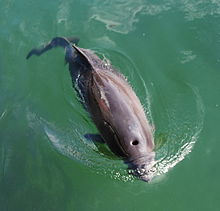
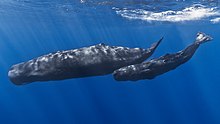




The order Cetacea includes whales, dolphins and porpoises. They are the mammals most fully adapted to aquatic life with a spindle-shaped nearly hairless body, protected by a thick layer of blubber, and forelimbs and tail modified to provide propulsion underwater.
- Suborder: Mysticeti
- Family: Balaenidae
- Genus: Balaena
- Bowhead whale, Balaena mysticetus LR/cd
- Genus: Eubalaena
- North Pacific right whale, Eubalaena japonica EN
- Genus: Balaena
- Family: Balaenopteridae
- Subfamily: Balaenopterinae
- Genus: Balaenoptera
- Common minke whale, Balaenoptera acutorostrata LR/nt
- Sei whale, Balaenoptera borealis EN
- Bryde's whale, Balaenoptera edeni DD
- Omura's whale, Balaenoptera omurai DD
- Blue whale, Balaenoptera musculus EN
- Fin whale, Balaenoptera physalus EN
- Genus: Balaenoptera
- Subfamily: Megapterinae
- Genus: Megaptera
- Humpback whale, Megaptera novaeangliae VU
- Genus: Megaptera
- Subfamily: Balaenopterinae
- Family: Eschrichtiidae
- Genus: Eschrichtius
- Gray whale, Eschrichtius robustus LR/cd
- Genus: Eschrichtius
- Family: Balaenidae
- Suborder: Odontoceti
- Superfamily: Platanistoidea
- Family: Monodontidae
- Genus: Delphinapterus
- Beluga, Delphinapterus leucas VU vagrant
- Genus: Delphinapterus
- Family: Phocoenidae
- Genus: Neophocaena
- Finless porpoise, Neophocaena phocaenoides DD
- Genus: Phocoena
- Harbour porpoise, Phocoena phocoena VU
- Genus: Phocoenoides
- Dall's porpoise, Phocoenoides dalli LR/cd
- Genus: Neophocaena
- Family: Physeteridae
- Genus: Physeter
- Sperm whale, Physeter macrocephalus VU
- Genus: Physeter
- Family: Kogiidae
- Genus: Kogia
- Pygmy sperm whale, Kogia breviceps LR/lc
- Dwarf sperm whale, Kogia sima LR/lc
- Genus: Kogia
- Family: Ziphidae
- Genus: Ziphius
- Cuvier's beaked whale, Ziphius cavirostris DD
- Genus: Berardius
- Baird's beaked whale, Berardius bairdii LR/cd
- Subfamily: Hyperoodontinae
- Genus: Indopacetus
- Tropical bottlenose whale, Indopacetus pacificus DD
- Genus: Mesoplodon
- Hubbs' beaked whale, Mesoplodon carlhubbsi DD
- Blainville's beaked whale, Mesoplodon densirostris DD
- Ginkgo-toothed beaked whale, Mesoplodon ginkgodens DD
- Stejneger's beaked whale, Mesoplodon stejnegeri DD
- Genus: Indopacetus
- Genus: Ziphius
- Family: Delphinidae (marine dolphins)
- Genus: Steno
- Rough-toothed dolphin, Steno bredanensis DD
- Genus: Tursiops
- Common bottlenose dolphin, Tursiops truncatus DD
- Genus: Stenella
- Pantropical spotted dolphin, Stenella attenuata LR/cd
- Striped dolphin, Stenella coeruleoalba LR/cd
- Spinner dolphin, Stenella longirostris LR/cd
- Genus: Delphinus
- Long-beaked common dolphin, Delphinus capensis LR/lc
- Short-beaked common dolphin, Delphinus delphis LR/lc
- Genus: Lagenodelphis
- Fraser's dolphin, Lagenodelphis hosei DD
- Genus: Lagenorhynchus
- Pacific white-sided dolphin, Lagenorhynchus obliquidens LR/lc
- Genus: Lissodelphis
- Northern right whale dolphin, Lissodelphis borealis LR/lc
- Genus: Grampus
- Risso's dolphin, Grampus griseus DD
- Genus: Peponocephala
- Melon-headed whale, Peponocephala electra LR/lc
- Genus: Feresa
- Pygmy killer whale, Feresa attenuata DD
- Genus: Pseudorca
- False killer whale, Pseudorca crassidens LR/lc
- Genus: Orcinus
- Orca, Orcinus orca LR/cd
- Genus: Globicephala
- Short-finned pilot whale, Globicephala macrorhynchus LR/cd
- Genus: Steno
- Family: Monodontidae
- Superfamily: Platanistoidea
Order: Carnivora (carnivorans)




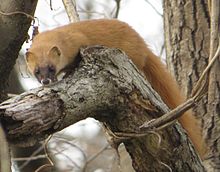


There are over 260 species of carnivorans, the majority of which feed primarily on meat. They have a characteristic skull shape and dentition. Wolves and otters are now believed to be extinct in Japan.
- Suborder: Feliformia
- Family: Felidae (cats)
- Subfamily: Felinae
- Genus: Lynx
- Eurasian lynx, Lynx lynx extirpated in prehistory[2]
- Genus: Prionailurus
- Leopard cat, Prionailurus bengalensis
- Iriomote cat, P. b. euptilura CR
- Leopard cat, Prionailurus bengalensis
- Genus: Lynx
- Subfamily: Felinae
- Family: Viverridae (civets)
- Genus: Paradoxurus
- Asian palm civet, Paradoxurus hermaphroditus LR/lc introduced
- Genus: Paguma
- Masked palm civet, Paguma larvata LR/lc introduced
- Genus: Paradoxurus
- Family: Herpestidae (mongooses)
- Genus: Herpestes
- Small Indian mongoose, Herpestes javanicus LR/lc introduced
- Genus: Herpestes
- Family: Procyonidae (raccoons)
- Genus: Procyon
- Common raccoon, Procyon lotor LC introduced
- Genus: Procyon
- Family: Felidae (cats)
- Suborder: Caniformia
- Family: Canidae (dogs, foxes)
- Genus: Vulpes
- Red fox, Vulpes vulpes
- Japanese fox, V. v. japonica LC
- Ezo red fox, V. v. schrencki LC
- Red fox, Vulpes vulpes
- Genus: Nyctereutes
- Raccoon dog, Nyctereutes procyonoides LC
- Japanese raccoon dog, N. p. viverrinus LC
- Raccoon dog, Nyctereutes procyonoides LC
- Genus: Canis
- Gray wolf, Canis lupus LC extirpated
- Hokkaido wolf, C. l. hattai EX
- Honshu wolf, C. l. hodophilax EX
- Gray wolf, Canis lupus LC extirpated
- Genus: Vulpes
- Family: Ursidae (bears)
- Genus: Ursus
- Brown bear, Ursus arctos LC
- Ussuri brown bear, U. a. lasiotus
- Asiatic black bear, Ursus thibetanus
- Japanese black bear, U. t. japonicus VU
- Brown bear, Ursus arctos LC
- Genus: Ursus
- Family: Mustelidae (mustelids)
- Genus: Mustela
- Stoat, Mustela erminea LR/lc
- Japanese weasel, Mustela itatsi LC
- Least weasel, Mustela nivalis LR/lc
- Genus: Martes
- Japanese marten, Martes melampus LR/lc
- Sable, Martes zibellina LR/lc
- Genus: Meles
- Japanese badger, Meles anakuma LC
- Genus: Lutra
- European otter, Lutra lutra
- Japanese otter, L. l. nippon EX
- European otter, Lutra lutra
- Genus: Enhydra
- Sea otter, Enhydra lutris EN
- Genus: Mustela
- Family: Otariidae (eared seals, sealions)
- Genus: Callorhinus
- Northern fur seal, Callorhinus ursinus VU
- Genus: Eumetopias
- Steller sea lion, Eumetopias jubatus EN
- Genus: Zalophus
- Japanese sea lion, Zalophus japonicus EX
- Genus: Callorhinus
- Family: Phocidae (earless seals)
- Genus: Erignathus
- Bearded seal, Erignathus barbatus LR/lc
- Genus: Histriophoca
- Ribbon seal, Histriophoca fasciata LR/lc
- Genus: Mirounga
- Northern elephant seal, Mirounga angustirostris LR/lc vagrant
- Genus: Phoca
- Spotted seal, Phoca largha LR/lc
- Common seal, Phoca vitulina LR/lc
- Genus: Pusa
- Ringed seal, Pusa hispida LR/lc
- Genus: Erignathus
- Family: Canidae (dogs, foxes)
Order: Artiodactyla (even-toed ungulates)


The even-toed ungulates are ungulates whose weight is borne about equally by the third and fourth toes, rather than mostly or entirely by the third as in perissodactyls. There are about 220 artiodactyl species, including many that are of great economic importance to humans.
- Family: Suidae (pigs)
- Subfamily: Suinae
- Genus: Sus
- Wild boar, Sus scrofa
- Japanese boar, Sus scrofa leucomystax
- Ryukyu boar Sus scrofa riukiuanus
- Wild boar, Sus scrofa
- Genus: Sus
- Subfamily: Suinae
- Family: Cervidae (deer)
- Family: Bovidae (cattle, antelope, sheep, goats)
- Subfamily: Caprinae
- Genus: Capricornus
- Japanese serow, Capricornis crispus LR/cd
- Genus: Capricornus
- Subfamily: Caprinae
See also
- List of animals in Japan
- Wildlife of Japan
- List of chordate orders
- Lists of mammals by region
- List of prehistoric mammals
- Mammal classification
- List of mammals described in the 2000s
Notes
- ^ This list is derived from the IUCN Red List which lists species of mammals and includes those mammals that have recently been classified as extinct (since 1500 AD). The taxonomy and naming of the individual species is based on those used in existing Wikipedia articles as of 21 May 2007 and supplemented by the common names and taxonomy from the IUCN, Smithsonian Institution, or University of Michigan where no Wikipedia article was available.
- ^ http://www.gmnh.pref.gunma.jp/wp-content/uploads/bulletin15_3.pdf
References
- "The IUCN Red List of Threatened Species: Mammals of Japan". IUCN. 2001. Retrieved 22 May 2007. [dead link]
- "Mammal Species of the World". Smithsonian National Museum of Natural History. 2005. Archived from the original on 27 April 2007. Retrieved 22 May 2007.
- "Animal Diversity Web". University of Michigan Museum of Zoology. 1995–2006. Retrieved 22 May 2007.
- "The Wild Mammals of Japan (S.D.Ohdachi et al. Edition). 2nd Printing version". Shoukadoh (Kyoto). 2010.
{{cite web}}: Missing or empty|url=(help)
